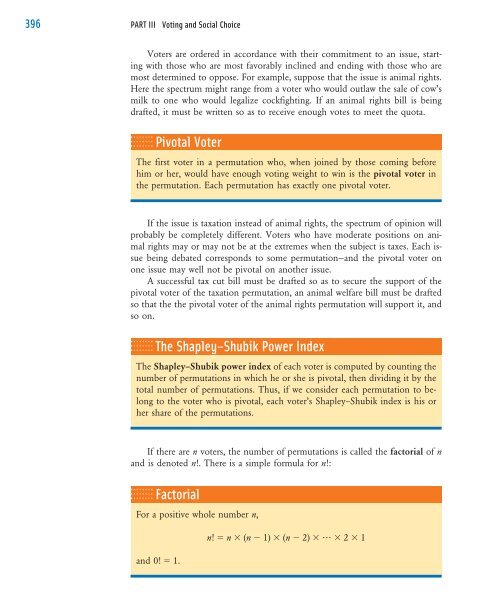Weighted Voting Systems - W.H. Freeman
Weighted Voting Systems - W.H. Freeman
Weighted Voting Systems - W.H. Freeman
- No tags were found...
You also want an ePaper? Increase the reach of your titles
YUMPU automatically turns print PDFs into web optimized ePapers that Google loves.
396 PART III <strong>Voting</strong> and Social ChoiceVoters are ordered in accordance with their commitment to an issue, startingwith those who are most favorably inclined and ending with those who aremost determined to oppose. For example, suppose that the issue is animal rights.Here the spectrum might range from a voter who would outlaw the sale of cow’smilk to one who would legalize cockfighting. If an animal rights bill is beingdrafted, it must be written so as to receive enough votes to meet the quota.Pivotal VoterThe first voter in a permutation who, when joined by those coming beforehim or her, would have enough voting weight to win is the pivotal voter inthe permutation. Each permutation has exactly one pivotal voter.If the issue is taxation instead of animal rights, the spectrum of opinion willprobably be completely different. Voters who have moderate positions on animalrights may or may not be at the extremes when the subject is taxes. Each issuebeing debated corresponds to some permutation—and the pivotal voter onone issue may well not be pivotal on another issue.A successful tax cut bill must be drafted so as to secure the support of thepivotal voter of the taxation permutation, an animal welfare bill must be draftedso that the the pivotal voter of the animal rights permutation will support it, andso on.The Shapley–Shubik Power IndexThe Shapley–Shubik power index of each voter is computed by counting thenumber of permutations in which he or she is pivotal, then dividing it by thetotal number of permutations. Thus, if we consider each permutation to belongto the voter who is pivotal, each voter’s Shapley–Shubik index is his orher share of the permutations.If there are n voters, the number of permutations is called the factorial of nand is denoted n!. There is a simple formula for n!:FactorialFor a positive whole number n,n! n (n 1) (n 2) 2 1and 0! 1.
















